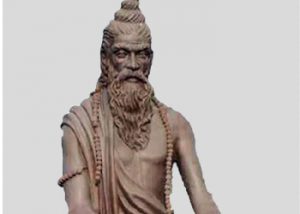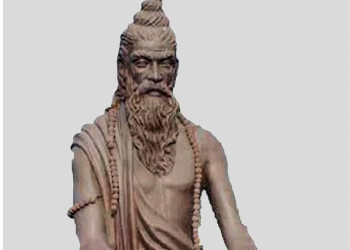- What is Abhyasa?
- Yoga Sutra 1.13, 1.14
- What is Vairagya?
- Yoga Sutra 1.15 and 1.16
- Combining both
- Applying in life

Patanjali’s Yoga Sutras is one of the greatest systems for mental exploration, presented to us centuries ago. Maharshi Patanjali explains that Yoga is the path to control the uncontrolled movements of the mind (Chittavrittis). Thus, the most fundamental practice, according to Patanjali, is the mental discipline of Yoga.
Patanjali does not limit the practice of Yoga to physical postures alone; he places greater emphasis on regulating the mind and thoughts, which are often the root cause of our suffering.
In this article, we will explore two key disciplines from Patanjali’s Yoga Sutras: Abhyasa and Vairagya. These two practices are considered the foundational steps to mastering the thoughts that arise in the mind. By mastering our thoughts, we gain control over the mind, thereby mastering it.
Sufferings originates from the mind
We see most of us undergo the Kleshas (causes of suffering) in some way or another. If we look at the nature of our problems, we can observe that most of them are originating from the mind. All the Chitta vrittis (unnecessary chattering of the mind) are the ones actually causing troubles, not mundane world problems (that seems like the cause of suffering).
To stop being regulated by the mind and to be able to regulate the mind itself, is one of the goals of Yoga. Patanjali points out the two most important disciplines that help regulate the mind and eventually lead the person to freedom from all the impressions of the mind.
These two disciplines are Abhyasa and Vairagya. They are explained in the first chapter of Yoga Sutra “Samadhi Pada” in verse 1.12. The sutra goes like this;

— Maharishi Patanjali, Yoga Sutras 1.12“Abhyavairagyabhyan Tannirodhaha”
Abhyasa and Vairgya are the two ways to calm the restlessness of the mind.
What is abhyasa?
The literal meaning of the word Abhyasa is ‘practice’ or ‘consistent study.’ For example, the study of Yoga is called Yogabhyasa.
The word Abhyasa is rooted in the concept of ‘to sit.’ However, it doesn’t imply casual sitting; rather, it refers to a deeper form of sitting one that is persistent, undisturbed by trivial distractions, and engaging enough to be enjoyed without experiencing boredom.
Abhyasa is the state where a person is fully immersed in serious practice, developing a drive for it. With continued practice, not only does the person improve, but they also develop a desire for more practice. Much like a young child learning to walk, the process is enjoyable despite the inevitable falls. The child persists, getting up again and again to continue practicing. This is the essence of Abhyasa.
Through Abhyasa, one can engage in the serious yet fulfilling practice of spiritual tasks, ultimately gaining mastery over the uncontrollable mind. It is the consistent effort to align our systems and bring them into harmony with one another.
Abhyasa according to the Yogasutras
In the yoga sutra, Abhyasa is defined in Sutra 1.13 and 1.14. Patanjali says in verse 1.13;

— Yoga Sutra 1.13‘Tatra Sthitau Yatno-bhyasah’.
Abhyasa is the practice or discipline employed to achieve and remain stable in the state of harmony with our own self.
However, the stability that is explained here is not of a temporary form. It means that the stability through Abhyasa, once achieved, should be present with you most or all of the time. Only then it’s considered Abhyasa.
Persistent repetition of the spiritual practice is key to discovering the calmer sides of the mind and settling there. That is why Patanjali further elaborates Abhyasa in verse 1.14 as the practice done for a long time, probably years, without interruptions. Abhyasa should be performed with great honor and respect. It is then that a person settles in Abhyasa and learns to negate the modifications of the mind.
After explaining Abhyasa, then comes the next discipline Vairagya.
What is vairagya?
Vairagya refers to non-attachment. It is often misunderstood as a behavior involving leaving one’s family, friends, and retreating to the Himalayas for spiritual growth. However, it is important to note that Vairagya is not limited to Sannyasis (renunciates); it is a practice for everyone. It involves detaching oneself from actions and, ultimately, from the impressions that accumulate in the mind.
The word Vairagya is derived from raga, which means coloring or attachment. Literally, Vairagya means “becoming colorless,” referring to the idea of shedding the “colors” or attachments to people, objects, ideas, and other material things.
Why is practicing non-attachment necessary? It is because the attachments we have to people or things influence our perceptions and create a false sense of identity. These attachments often lead to suffering, as we are constantly at the mercy of external conditions.
Just as we naturally desire material possessions, this tendency is the first step toward attachment. The practice of refraining the mind from unnecessary possessions is called Aparigraha, the last of the five Yamas in yoga. Therefore, Aparigraha can be considered a preparatory practice for Vairagya.
Vairagya according to the yogasutras
Verse 1.15 explains Vairagya as ‘Drishta Anushravika Vishaya Vritrishnasya Vashikara Sanjna Vairagyam’. It means ‘when the mind loses desires for the objects that are seen, described in tradition or mentioned in the scriptures, it acquires a state of pure desirelessness (vashikara). This state is called Vairagya.
Our mental energies are always stuck upon the pleasurable things that we see or hear. Patanjali asks us to extract those energies from the object and give them a path that can lead us to mental freedom. It’s the first step to the path of Vairagya.
Vairagya is an essential quality of the yogi to gain mastery over the visible or invisible attachments. It is the abandonment of the false impressions of the mind which create unreal interpretations of ourselves and the world around us.
Patanjali further elaborates on this in verse 1.16 ‘Tat Param Purusha Khyateh Guna Vaitrshnyam’. It means that non-attachment to the subtlest elements, constituent principles or the qualities (3 Gunas) themselves, achieved through the knowledge of pure consciousness, is called supreme non-attachment (Param Vairagya).
Patanjali calls Param Vairagya or the highest form of Vairagya to that state in which the yogi is detached from not only the gross aspects of the world but also becomes so unattached that he gives up Sattva, Rajas and Tamas themselves.
Patanjali says that when a yogi is able to distinguish between the true and false impressions of the mind, he learns Vairagya. And when he is settled in his true self, he understands that the true happiness lies within and not outside. Hence, by renouncing all the outer attachments, the yogi is blissed in his own real self.
How do abhyasa and vairagya work together?

The concepts of Abhyasa and Vairagya, though seemingly opposite, work together as mental pillars to regulate our mind. They are complementary processes that support self-exploration.
Practicing these two principles means finding a balance between effort and ease. For example, through Abhyasa, you put in significant effort into a task (or “practice”), but through Vairagya, you find ease in that practice by not becoming attached to it. In this way, the two disciplines complement each other.
Abhyasa provides the path to self-exploration, while Vairagya ensures that you stay on that path, undistracted by worldly attachments. Simply put, if Abhyasa teaches you to practice mental disciplines with humility and respect, Vairagya ensures that you are not distracted by the attachments of the world during your practice.
Applying abhyasa and aairagya in day-to-day Life
As social beings, we are constantly influenced by everything happening around us—whether in society or our immediate surroundings affecting us physically, mentally, and emotionally. The increasing changes in the external world are also beginning to impact our inner world.
To restore balance in our minds, it is essential to practice Abhyasa and Vairagya in our daily lives. Here are some ways to integrate both Abhyasa and Vairagya into your routine.
1. Combine Effort and Ease
Abhyasa and Vairagya are two essential keys to achieving higher mental functioning. To cultivate these qualities, you can begin by combining both effortful and calming practices in your exercise routine. Start with vigorous exercises like jogging, cycling, 108 Sun salutations,, or other body-loosening movements. Afterward, balance these with calming practices like yin yoga, deep breathing, and mindful meditation.
The effort you put into the more demanding exercises reflects your Abhyasa, as you engage in them with focus and energy. These practices help clear your mind and alleviate boredom. On the other hand, the quieter exercises foster a sense of calm, allowing you to detach the mind from external distractions -embodying the principle of Vairagya.
2. Mentally Travel from Gross to Subtle
The practice of Abhyasa and Vairagya requires mindful effort. You must observe what comes and goes in your mind. When you sit on your mat for meditation or deep breathing, ensure you remain aware of the thoughts and projections arising in your mind.
This awareness will naturally develop as you learn to understand your mental workings, from the most obvious to the subtle. When you meditate, observe the trivial thoughts that your mind creates. As you recognize and eventually dissociate from them, you will move toward the subtler aspects of your mind.
This exercise will reveal how our mind plays subtle tricks on us, and how, through dedicated yoga practice, we can learn to overcome them.
3. Keep yourself engaged while being aware of yourself
Awareness is the essence of meditation and the best way to integrate Abhyasa and Vairagya. The reason we struggle to maintain a consistent practice (Abhyasa) is because we quickly lose awareness after starting. By becoming truly aware of ourselves, we can prevent the mind from drifting into positive or negative patterns during practice.
Therefore, awareness is key to sustaining both Abhyasa and Vairagya. Cultivate awareness in every aspect of life: be mindful of what you are thinking, doing, eating, how you are breathing, and how you are feeling.
4. Keep practicing
The key to staying in the rhythm of a yogic lifestyle is never ceasing to practice. Abhyasa may sometimes feel like a struggle, but it is the most essential element for achieving positive mental health. Through consistent, dedicated practice, you can learn to distinguish your true self from the version created by your mind. This, in turn, will help you release the false impressions that cloud your perception.
When practicing asanas, maintain steadiness. It is through steadiness that calmness arises, allowing you to clear the mind of distractions.
Therefore, continue living the yogic lifestyle both on and off the mat. Do not let mental afflictions control you. Instead, through Abhyasa and Vairagya, take control of your mind.
5. Keeping track of your Attachments and Aversions
As mentioned earlier, Vairagya is not just the practice of letting go; it is the practice of not attaching to things in the first place. To practice Vairagya in daily life, start by making a list of your attachments and aversions things, people, habits, or ideas that you are drawn to, and those that you have an aversion to.
This exercise helps you distinguish between what you truly need and what you don’t. Once you recognize the difference between what you genuinely desire and what your mind irrationally craves, you gain the ability to discern the real from the unreal. As this realization unfolds, you can further cultivate non-attachment through deeper meditation.
6. Minimize the Coloring of the Mind
Our mind is an expert at creating a colorful world for us. Often, these colors represent false interpretations of ourselves and the world around us. They are reflected in our pleasures, likes, dislikes, desires, greed, and more.
Through practices like meditation, deep breathing, and focus, you can reduce this “coloring” of the mind. When you immerse yourself fully in the practice of yoga, you become less dependent on material things. Acceptance naturally arises as the fruit of a consistent yogic routine.
Conclusion
Abhyasa and Vairagya are the two essential pillars on the path of Yoga. If either is neglected or not practiced, reaching Samadhi, the ultimate goal of yoga, becomes impossible. The key to calming the wandering mind lies in the consistent practice of Abhyasa and Vairagya.
Maharshi Patanjali emphasized the importance of these two principles as foundational tools for regulating the mind, freeing it from unnecessary distractions and sources of suffering. By firmly establishing ourselves in these practices, we can gain control over the mind and ultimately recognize its Swaroopa (true nature or self).

![What is Bija Mantra? Meaning and Benefits of Seed Mantras [List] What is Bija Mantra? Meaning and Benefits of Seed Mantras [List]](https://www.fitsri.com/wp-content/uploads/2021/12/bija-mantra-211x150.jpg)


